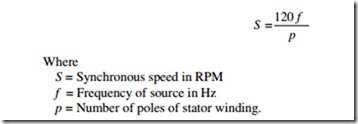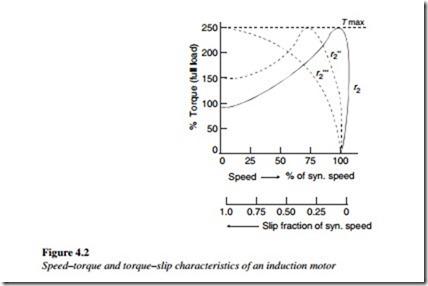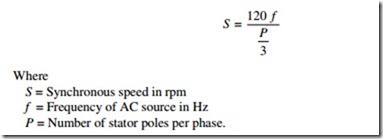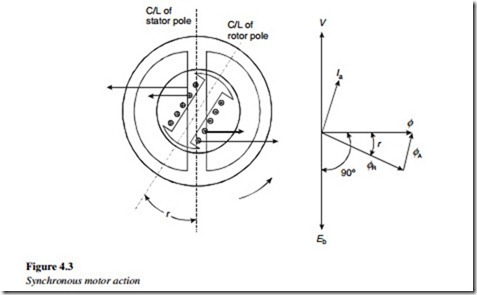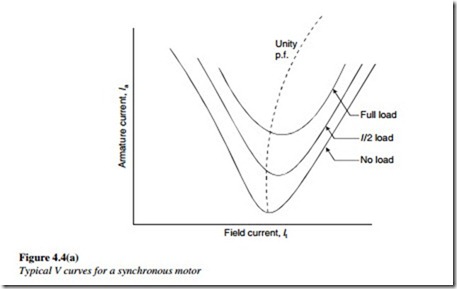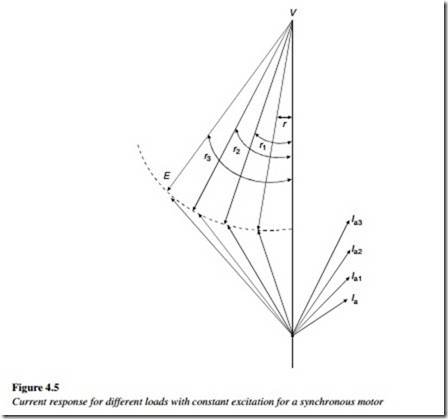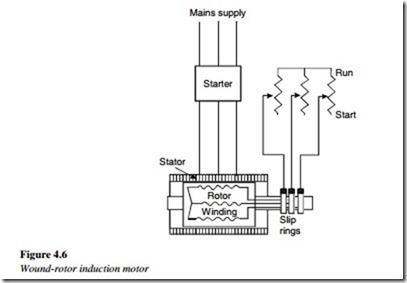Fundamentals of three-phase AC motors
Three-phase AC motors are known as the ‘workhorses of industry’ because of their wide use and acceptance. They are popular because they are low in cost, compact in size, require less maintenance, withstand harsh industrial environments, etc.
Three-phase AC motors are a class of motors that convert the three-phase electric power supplied at the input terminals, to mechanical power at the rotating shaft, through the action of a rotating magnetic field, produced by a distributed winding on the stator.
Three-phase AC motors are broadly classified as:
1. Induction motor
2. Synchronous motor
3. Wound rotor induction motor. Each motor operation is detailed briefly.
1. Induction motor
As the name implies, no voltage is applied to the rotor. The voltage is applied to the stator winding and when the current flows in the stator winding, a current is induced in the rotor by transformer action. The resulting rotor magnetic field will interact with the stator magnetic field, causing torque to exert on the rotor.
2. Synchronous motor
As the name suggests, rotor speed remains in synchronism with that of the stator magnetic field. The motor runs at the same speed.
Unlike induction motors, synchronous motors are not self-starting. They have to be brought up to synchronous speed. Once they are locked then the rotor will continuously rotate.
3. Wound rotor induction motor
This motor has a ‘wire wound rotor’ from which three leads are brought out to the slip rings. It is possible to vary the rotor resistance. Introducing different resistances in the rotor circuit through the slip rings does this. The speed and the starting torque will now be variable.
Principles and operation of three-phase induction motors
Three-phase induction motors have three coils, placed 120 electrical degrees apart from each other, which form the stator winding.
Whereas a rotor is a squirrel-cage type (solid one) and has copper conductors, which are shorted at one end by a circular connecting plate. In Figure 4.1, a squirrel-cage induction motor is shown.
When voltage is applied to the stator winding, current flows through it, creating a rotating magnetic field. The speed of this rotating magnetic field depends on the number of poles of the stator, and the frequency of supply given to it. This is known as Synchronous speed and is given as:
The rotating magnetic field induces emf in the rotor by the transformer action. Since the rotor is a closed set of conductors, current flows in the rotor. The rotating fields due to stator currents react with the rotor currents, to produce forces on the rotor conductors and torques.
This motor is called an induction motor, as it works on the principle of transformer action or induction.
Characteristics of a three-phase induction motor:
• No external starting mechanism is required.
• They come in a variety of horsepower ratings.
• Speed is inherently constant.
• The direction of rotation can be changed easily by reversing any two power lines of the motor.
• Motor runs at a speed lower than the synchronous speed by a factor ‘slip’.
• For reduced loads, the power factor becomes poor.
• Multi-speed squirrel-cage motors are available with a provision of changing the number of stator poles by changing external connections.
Speed–torque characteristics of an induction motor
The speed–torque characteristics and torque–slip characteristics of an induction motor are important parameters for determining the performance of the motor. Typical speed– torque characteristic and torque–slip characteristics of a three-phase induction motor are shown in Figure 4.2.
It can be seen that when a motor starts from zero speed, the start torque is lower than the full load torque and the motor can start at light-to-no load.
The normal full load torque is achieved at a point where the rotor speed is only 5% less than the synchronous speed. From this point onwards, the torque drops to zero value since there is no relative motion or slip between the stator and the rotor.
In order to achieve a high starting torque, the rotor is made with high-resistanceconductors or else an external resistance is inserted in the rotor circuit.
The nature of the characteristic curve can be changed, in case of a slip-ring type induction motor, by inserting an external resistance in the rotor circuit. If the rotor resistance is increased from r1 to r2, r3, r4 (r1 < r2 < r3 < r4), then the maximum torque remains the same, but the slip at which the maximum torque occurs is shifted, as shown in Figure 4.2. The method of introducing an external resistance in rotor circuit is used, to obtain a higher starting torque, as required, up to the maximum torque limit that the motor can produce. This method of increasing the starting torque can be used only in the case of slip ring or wound rotor induction motors.
Induction motor startup
The main objectives while starting an induction motor are:
• To handle high-starting current
• To achieve high-starting torque.
As discussed earlier, rotor resistance determines starting torque. Usually, this rotor resistance is small, giving small starting torque, but good running conditions. So, the squirrel-cage motor can run only with low-starting loads.
If the rotor resistance is increased by some means, then the slip and speed at which maximum torque occurs can be shifted. For that purpose, external resistance can be introduced in the rotor circuit, which is done in the case of slip ring or wound rotor type motors.
When power is applied to a stationary rotor, excessive current will start flowing. This
happens due to the fact that there is a transformer action between the stator winding and the rotor winding, and the rotor conductors are short-circuited. This causes heavy current flow through the rotor.
If, for reducing this heavy starting current, starting voltage applied is reduced then it affects the starting torque as well.
To get everything out, the following method of starting is generally used:
• DOL starting
• Auto transformer starting
• Star–delta starting.
Induction motor losses and efficiency
The following are the losses in an induction motor:
• Core loss in the stator and the rotor
• Stator and rotor copper losses
• Friction and windage loss.
Core loss is due to the main and leakage fluxes. As the voltage is assumed constant, the core loss can also be approximated as a constant. DC can measure the stator resistance. The hysteresis and eddy current loss in the conductors increase the resistance, and the effective resistance is taken at 1.2 times the DC resistance. The rotor copper loss is calculated by subtracting the stator copper loss from the total measured loss or the rotor I2R loss. The friction and windage loss may be assumed constant, irrespective of the load.
Efficiency = Rotor output/stator input Output = Input − Losses
Example 4.1
Consider a three-phase 440 V, 50 Hz, six-pole induction motor. The motor takes 50 kW at 960 rpm for a certain load. Assume stator losses of 1 kW and friction and windage loss of 1.5 kW. To determine the percentage slip, rotor copper loss, rotor output, and efficiency of the motor, perform the following function:
Percentage slip
The synchronous speed of the motor = (50 × 120) / 6 = 6000 / 6 = 1000 rpm Slip = (Synchronous speed – Actual speed) = 1000 – 960 = 40 rpm Percentage slip = [(40 / 1000) × 100] = 4% = 0.04
Rotor copper loss
Rotor input = 50 −1 = 49 kW Rotor copper loss = Rotor input × Slip
= 49 × 0.04 = 1.96 kW
Rotor output
Rotor output = Rotor input − Rotor copper loss − Friction and Windage loss
= 49 −1.96 −1.5
= 49 − 3.46
= 45.54 kW
Motor efficiency
Motor efficiency = Rotor output/Motor input
= 45.54 / 50 = 0.9108
= 91.08%
Principle and operation of a three-phase synchronous motor
The three-phase synchronous motor is considered as a constant-speed motor with large size and high ratings. As the name suggests, it runs from no load to full load at the same speed. As we have seen in an induction motor, there is a slip. However, here the motor runs at the same speed as that of the rotating magnetic field.
The construction of a synchronous motor is similar to that of an alternator. The stator winding is connected to the three-phase supply and the rotor has a DC field winding.
When three-phase voltage is supplied to the stator winding, this produces a rotating magnetic field. The torque .produced on the rotor is in a direction which will make the rotor field align with that of the stator. In a stationary rotor the torque is first in one direction and then the direction reverses depending on the relative positions of the stator’s rotating magnetic field and the rotor’s magnetic field. Due to the inertia of the rotor, it will not move in any direction. That is why synchronous motors are not self- starting.
Now, if it is made to run at some speed, then gradually, the stator and rotor poles of opposite polarity will be locked with each other causing the rotor to run in synchronism with that of the stator’s rotating magnetic field. Thus, the rotor will run at a synchronous speed.
To make this happen, a synchronous motor is made to run like a normal induction motor at first, and then, like a synchronous motor.
For that purpose, the rotor has two windings, one is the AC winding, like a squirrel- cage winding or a wound rotor type, and the second is the DC winding. Stator winding is similar to the induction motor.
The three-phase synchronous motor differs from an induction motor, in that the rotor is wound and is connected to a DC source through the slip rings.
The motor starts as a normal induction motor (squirrel-cage/rotor-wound), once the speed of the rotor reaches 90–95% of synchronous speed; then a DC source is applied to the DC winding of the rotor. This in turn, produces the north and south poles in the rotor. The rotor magnet is now locked on to the rotating magnetic field of the stator and runs at a synchronous speed given by:
However, it is necessary to have an angle between the centerline of the stator pole and the centerline of the rotor pole or field, as shown in Figure 4.3. If the excitation is kept constant, during the operation of the synchronous motor, and the load is increased, it produces a change in the current and in the power factor of the motor.
The characteristics of a three-phase synchronous motor are given below:
• Constant-speed motor
• Can be used to correct power factor of a three-phase system
• Is not self-starting
• Used generally in load applications requiring constant speed with infrequent starts and stops.
‘V’ curves
If the armature current of a synchronous motor is plotted against the field current of the motor for a constant mechanical output, the curve produced is known as the V curve.
V curves can be drawn or obtained by tests, for various values of the loads maintained constant during these tests. Typical V curves for a synchronous motor for ‘no load’, 50% of full load, and full load are shown in Figure 4.4(a).
If a constant power is delivered, the armature current is reduced and the power factor
lags as the field current increases. Then it becomes minimum at unity power factor. Again, it increases for leading power factor forming a V-shape characteristic.
If the power factor for constant output, is plotted against the field current, the plot will be an inversion of the V curve, as shown in Figure 4.4(b).
Losses and efficiency of a synchronous motor The following are the types of losses in a synchronous motor:
• Fixed losses include core loss, friction and windage loss, and brush friction loss. These losses can be obtained from a no-load test.
• I 2R loss in armature windings and stray losses in conductors.
• Excitation circuit losses including field copper loss, rheostat loss, and brush contact losses.
Hunting of synchronous motors
This is a problem associated with synchronous motors. As the load on the motor increases, the angle between the stator pole and the locked rotor pole gradually increases. The rotor of the motor falls back by a certain angle, behind the poles of the forward rotating field, in order to produce the necessary torque. The stator current will also increase. While the motor speed slows down, it will remain synchronized, unless the load causes synchronization or the locking (of the rotor pole) breaks.
An increase in phase difference causes the motor to draw more current from the mains and increase power flow in the armature. Some of the kinetic energy of the rotating parts is transferred to the load during a speed slow down.
The motor cannot decelerate exactly at the required torque angle of the increased load. It passes beyond this, develops more torque, and increases the speed. This is followed by a reduction in speed and the cycle is repeated. If the load is suddenly thrown off, the rotor poles are pulled into almost opposition to the poles of the forward field, but due to the rotor inertia, the rotor poles travel too far, and are pulled back again. This results in oscillations about the position of equilibrium corresponding to the load conditions on the motor. This periodic change in speed is known as hunting.
The phasor diagram for sudden increase in the load of a synchronous motor is shown in Figure 4.5.
The armature current increases from Ia to Ia1, Ia2, Ia3, etc., and the torque angle increases from γ, to γ1, γ2, γ3, etc. The excitation voltage (E ) is assumed to be a constant. If the variations in the load are periodic and are synchronized with the natural frequency of the oscillation of the rotor, the amplitude of these oscillations increases cumulatively, and becomes so great, that the motor may fall out of step.
In order to sort it out, it is required to damp the oscillations and prevent an increase in the amplitude of swinging.
This is achieved by providing a damper winding in the pole shoe of the synchronous
motor. When hunting occurs, there is a shift of flux across the faces of the pole shoe, due to the effect of the armature reaction on the field flux. The shifting flux induces circulating currents in the damper winding. The kinetic energy of oscillations is dampened by being converted into heat energy. The induced current opposes the change in the relative positions of the armature flux and the field flux, and thus acts as an effective damper.
Thus, this problem of hunting in synchronous motors can be avoided.
Principle and operation of a three-phase wound rotor motor In addition to a squirrel-cage, a wound-rotor induction motor has a series of coils set into the rotor. These are connected through the slip rings to external variable resistors.
The three-phase rotor connections are then brought up to slip rings. It is now possible to vary the rotor resistance, by introducing a different resistance in the rotor circuit through the slip rings provided. The speed and the starting torque will vary. The stator winding is similar to an induction motor with an individual three-phase winding placed 120° electrically apart.
In Figure 4.6, a wound-rotor induction motor is shown. It works as a normal induction motor with a three-phase supply given to stator windings. The only difference is that the speed varies depending on the rotor resistance.
High-starting torque is obtained with a low-starting current. When no resistance is introduced, the motor will run at full speed. As resistance is increased in the rotor circuit, the speed will reduce. For normal running, the slip rings are short-circuited.
Wound-rotor motor startup
For a high-starting torque, the motor is started with the rotor circuit starter resistance in the circuit.
As the motor gains speed, the rotor resistance is reduced gradually. This will shift the synchronous speed and maximize the torque curve from the wound-rotor motor to an induction motor curve. Finally, the rotor or slip rings will be short-circuited.
For some motors, the rotor resistance is introduced in small steps.
Merely interchanging the two supply voltage leads can change the direction of the motor.
The following are the characteristics of a three-phase wound-rotor motor:
• Achieve high-starting torque with low-starting current
• Generally used in applications where on load starting is required
• Is self-starting
• Speed adjustment is possible up to a good extent
• Speed varies a lot when used with the rotor resistance in picture.
The high starting torque of the wound rotor motor and the capability to control the speed by varying the resistance has made this form of motor popular for lifting applications such as hoists and cranes. Also, the relatively lower starting current and the high torque makes it a popular choice for large capacity drives on weak electrical systems and for high inertia loads such as rotary kilns and blowers.
